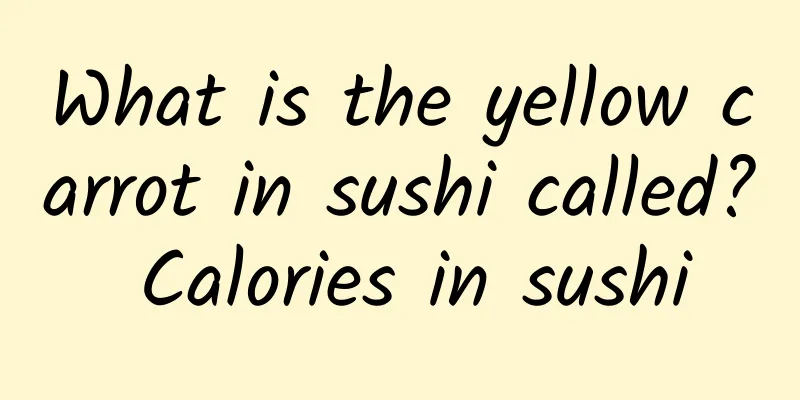What is the yellow carrot in sushi called? Calories in sushi

|
There are many kinds of sushi, and the colors are very bright. Sushi is also called sushi, sushi, and salted fish, which means salted fish pickled with salt and rice. Sushi is made of vinegar rice with raw, cooked or pickled ingredients. It is relatively small in size and needs to be eaten with dipping sauce. Many friends want to know the difference between sushi and rice balls. The following is a detailed sharing. Contents of this article 1. What is the yellow radish in sushi called? 2. Calories of Sushi 3. The difference between rice balls and sushi 1What is the yellow radish in sushi called?The yellow radish in sushi is called daikon, which is actually pickled white radish, because the Japanese kanji for radish is daikon. The stem of daikon is pure white, and after being sealed, pickled and fermented, it turns naturally yellowish, and browns when exposed to light. In order to preserve the color, pigments are usually added before it turns brown. The yellow radish in sushi is called sushi radish strips, sushi daikon strips, Japanese daikon, salted radish, etc. The "daikon" here is radish in Japanese. This kind of radish can be easily made at home. Just cut the radish into strips and marinate in salt water for half an hour. Then pour water, sugar and gardenia into a pot and boil. Then take out the radish and put it in the boiled gardenia water and refrigerate and marinate for two nights. In addition to making sushi, daikon radish can also be diced and stewed with meat (beef is preferred), diced with pork or lamb and fried rice, or stir-fried directly into dishes. 2Calories in SushiThe calories of sushi per 100g are 2220.47 kilojoules. Sushi is also called sushi, sushi, and salted fish, which means salted fish pickled with salt and rice. There are many kinds of sushi, and the colors of sushi are very bright. Sushi is a Japanese dish with vinegar as the main ingredient in rice. Sushi was born in the late Yayoi period. The ingredients of sushi are fresh sea urchin roe, abalone, prawns, scallops, salmon roe, cod milt, tuna, salmon and other seafood and rice balls. The types of sushi include box sushi, rolled sushi, too-large rolls, thin rolls, hand rolls, inner rolls, pressed sushi, nigiri sushi, inari sushi, and chirashi sushi. Some of the ingredients of sushi are raw, some are cooked, and some are pickled. The ingredients include cucumbers, sausages, mushrooms, scrambled egg skins, fish floss, etc. 3The difference between rice balls and sushiThe main differences between rice balls and sushi are appearance, ingredients and eating methods. Rice balls are mainly made of rice and other ingredients. The shape can be made according to your own preferences. They are generally round and large in shape and can be eaten directly. Sushi is made of vinegar rice with raw, cooked or pickled ingredients. It is smaller in size and needs to be dipped in sauce before eating. Because most of the ingredients used in sushi are raw and cold, using dipping sauces can reduce the fishy smell of the ingredients to a certain extent. Common shapes of rice balls include triangle, straw bag, spherical, oblate, etc. Sushi and rice balls are both traditional Japanese foods. They are popular among the public because they are simple and convenient to make, and taste delicious and not greasy. |
>>: What kind of rice is better for making sushi? How long can sushi be kept?
Recommend
What happened to my period being delayed for 20 days?
Delayed menstruation is a problem encountered by ...
I didn't sweat today, can I skip a shower? The answer is unexpected
It's really hot recently. As soon as I leave ...
What are the differences between ticagrelor and clopidogrel, commonly used drugs for coronary heart disease?
For patients with acute coronary syndrome and tho...
Understand Parkinson's disease, know "Parkinson" and don't be afraid
Author: Liu Na, deputy chief physician, Peking Un...
How many times can a woman have an abortion?
Abortion is a common surgery to terminate pregnan...
Hawthorn with a treasure, three highs will not come to you! Chinese medicine experts and nutritionists prefer it
Candied haws, sugar snowballs, fruit jelly, hawth...
Analysis of varicose veins of the vulva in pregnant women
Varicose veins of the vulva in pregnant women is ...
Mobile Future Institute: The funnel model is dead in the era of mobile e-commerce!
Last year, I had the honor of chatting with Aliba...
What fruits can girls eat when they have their period?
Fresh fruit is a good thing, especially women sho...
Fight eye bags, beauty-conscious women should not miss these 5 tricks
Bags under the eyes are a problem that worries ma...
What does scarred uterus mean?
What does a scarred uterus mean? A scarred uterus...
What are the effects of removing one fallopian tube on women?
Removing one side of the fallopian tube has no ef...
Can I get pregnant if I have Ureaplasma urealyticum?
Ureaplasma urealyticum is not often mentioned in ...
Female secretion examination
The examination of female secretions is a very im...
Hysterosalpingography is painful
Hysterosalpingography is a very common gynecologi...









